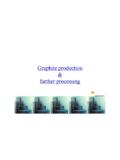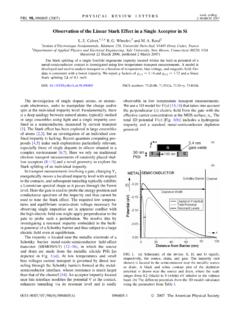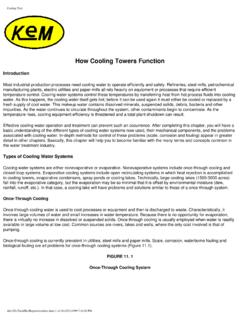Transcription of SUGAR BOILING THE SYRUPS IN THE VACUUM PANS
1 1 SUGAR BOILINGTHE SYRUPS IN THE VACUUM PANSby John ZieglerIn the SUGAR BOILING process, it is most desirable toknow the syrup concentration at all times so that itssupersaturation may be held within certain limits. If it iscarried too low, the crystallization rate suffers andabove a maximum value, unwanted spontaneous grainformation takes placeOne of the most practical means of measuring thisimportant variable is by the temperature of the boilingsyrup at a known absolute pressure or by reference tothe temperature of water BOILING at the same so-called BOILING Point Elevation or BPE haslong been used for this purpose. A considerableamount of care must be exercised in making thetemperature measurements if they are to yield anaccurate measure of supersaturation because the BPErange of interest covers only a few degreesCentigrade.
2 The normal temperature gradients invacuum pans make intolerable errors if the syruptemperature is taken even a short distance below theboiling surface. This poses some mechanical problemsdue to changing pan level but one widely usedtechnique is to take the temperature of vapor leavingthe pan as it will be at the surface temperature. Moreof measurement problems order to convert a BPE reading into the degree ofsupersaturation, one must know the sucrose solubilityin the particular syrup at the BOILING temperature andthe BPE it produces at any concentration of totalsolids. This paper reports an investigation of theliterature to see if reasonably accurate figures for thesolubility and BPE of typical beet and cane syrupscould be established over the range of valuesencountered in VACUUM pan work.
3 Not surprisingly,perfect agreement is lacking in the values reported byvarious investigators even on pure SYRUPS , probablyoccasioned by experimental errors. Add to this the factthat the composition of the nonsucrose componentspresent in lower purity SYRUPS affects both values tosome extent. However, by restricting the investigationto the normal temperatures, concentrations andpurities of pan SYRUPS , excluding those in crystallizers,dangerous extrapolation was avoided and fair averagevalues the ProblemIn VACUUM pans, SYRUPS are generally boiled at sometemperature between 650C and 850C with a goodaverage in the 750C region. This fixes the operatingpressure in the 4" to 9" Hg Abs range. Pans operatedat a lower pressure suffer from poor overall massecuitecirculation and high temperatures increase theprobability of syrup only syrup concentrations of interest in panoperation lie above saturation and below the limit of themetastable zone where spontaneous nucleation takesplace.
4 This limit appears to be near on higher purity SYRUPS and of thesame order of magnitude on those of lower normal VACUUM pan work, there is no need toconsider SYRUPS of lower purity than they reach at pandrop. Beet SYRUPS below 65 purity and cane syrupsbelow 50 purity are only encountered in finalcrystallizer exhaustion of Solubility-Pure SyrupsThere seems to be little disagreement between themany investigators of pure sucrose solubility, at leastover the ranges of interest here. Brown and Nees (1),Charles (2), Grut (3), Thieme (4) and others are wellwithin the tolerance presently required. Currently thesolubilities of Vavrinecz (5) given in Table 1 are thosetentatively accepted by ICUMSA and seem to be aweighted average of previous 1.
5 Solubility - Pure Sucrose.(Tentative ICUMSA Standard)Temperature(0C)S/W(g Sucrose /g water) SolubilityImpure Beet SyrupsThe basis for Table 2 covering these SYRUPS was thewell known Grut solubility Table 3 since the values arein quite good agreement with those of otherinvestigators. The Wiklund (6) relationship curves wereplotted over the range of temperatures and purities ofinterest in pan work and it was found that the bestaverage solubility coefficient was expressed by theequation: C = N/W + where C is the ratio ofsucrose/water at saturation in the impure solutiondivided by the sucrose/water in a saturated solution ofpure sucrose at the same temperature. N/W is thenon-sucrose/water ratio in the impure solution. TheWiklund relationship is linear for solutions with N/Wabove and serves as a valuable guide for plottingthe solubilities of the lower purity pan 2.
6 Beet Syrup Solubility.(g Sucrose / g water) 's 100 purity solubilities were slightly higher thanthe newer values given in Table 1 so his values weredropped about 3% in the higher purity regions to SolubilityImpure Cane SyrupsTable 3 solubility values are based on the data ofThieme (4) which are in close agreement. His highpurity values were slightly lower than those ofVavrinecz in Table 1 so a minor upward adjustment oftheir figures was 3. Cane Syrup Solubility.(g Sucrose / g water) Chart ConstructionA plot of solubility information can be useful ininterpolating between points and in picturing changingsyrup conditions during the course of the boilingprocess. The chart described here has proven mosthelpful in this regard. A basic chart is first constructedfor any syrup and to it the temperature contours can beadded showing saturation conditions for a specificsyrup being processed.
7 It need not have the impuritycharacteristics of the SYRUPS of Tables 2 and 3 butonce its solubility data have been determined it iseasily applied to the basic chart. Then a laboratorydetermination of massecuite or mother liquorconcentrations and purities locates a point on the chartand calculation of syrup supersaturation, crystal yieldand other important variables is greatly basic chart of Figure 1 plots sucrose/water ratio,S/W, against syrup purity over the range of interest inpan operation. Purity is given as the percent of totalsolids that are sucrose. The syrup concentration linesare then added as percent by weight of dry substance,refractometer dry substance or brix since it is usuallygiven this dimension in lab reports rather than drysubstance/water.
8 They are located as follows: the 80rds line crosses 100 purity at 80/20 or S/W = 4 and at50 purity S/W = 2. At 100 purity and 86 rds the sucroseratio would be 86/14 = and at 50 purity it would beonly half as great or S/W = 1. Basic Solubility ChartNonsucrose/water lines are then added: for example,the N/W = 2 line would intersect the S/W = 6 line at apurity of 6/(6 + 2) = 75% and at S/W = 3 at a purity of3/(3 + 2) = 60% and so may then superimpose temperature contours fromexperimentally derived information on any particularsyrup. A typical plot using the figures from Table 2have been added on Figure 2. As expected, the linesslope upward with decreasing purity because of theincrease in sucrose solubility caused by beet 2. Beet Syrup SolubilityFigure 3 is a similar plot for typical cane SYRUPS usingthe data of Table 3 The "salting out" effect of caneimpurities is readily apparent since sucrose solubilitiesdecrease at lower 3.
9 Cane Syrup SolubilitySupersaturationMany ratios have been used in the literature todescribe the condition of SYRUPS with more or lessmaterial in solution than would exist if it were justsaturated. This has caused considerable confusion. Inthis paper a straightforward ratio will be used, namely,the total solids to water content of the syrup divided bythe total solids to water content in a saturated solutionat the same temperature and purity. Numerically thesame value is obtained if one takes the sucrose towater content divided by the sucrose to water thatwould be present in a saturated solution at the sametemperature and example will make this doubly clear. An 80 puritycane syrup at 750C from Table 3 would be saturatedwhen S/W = Take out water until S/W = andits supersaturation would be = or 50%oversaturated.
10 Add water until S/W is and thesupersaturation would be = or 25% same syrup at saturation would have = g total solids per g water and if concentrated untilit had = g total solids per g water wouldlikewise be = 4. Solubility Chart ExampleUsing Solubility ChartsThe type of solubility charts presented here can beused to plot syrup conditions during the entire courseof a strike and the subsequent crystallization processalthough the latter is beyond the scope of the a typical low raw beet strike boiled at 750 Cand fed with 76 purity machine syrup throughout. Thechart of Figure 4 shows only the contours of interestduring the BOILING graining syrup charge is brought into the pan and, asit is concentrated, the S/W increases until a proofsample shows it to be 87 rds, point A.






